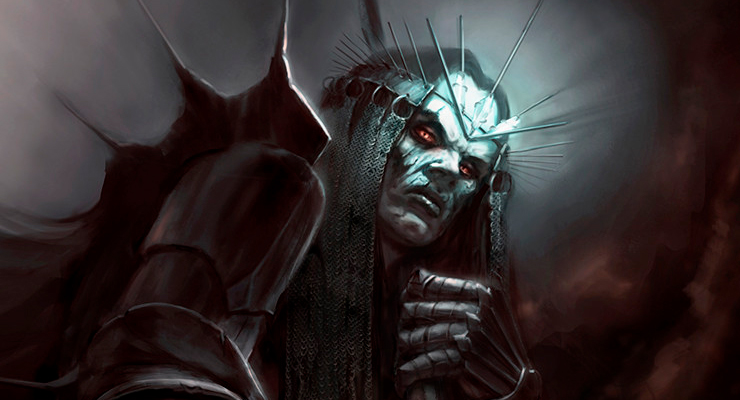In this scattershot series, we’ll be delving “too greedily and too deep,” prying gems out of the glorious rough that is the extended legendarium of Tolkien’s world. This includes drawing on The Lord of the Rings itself, The Hobbit, The Silmarillion, The Children of Húrin, and the History of Middle-earth (or HoMe) books.
Whenever the works of J.R.R. Tolkien come up, my immediate nerd-impulse is to ask: “Hold up! Are we talking about just The Lord of the Rings and The Hobbit?” Followed by, “Are we talking about the films or the books (since they’re quite a different thing)—or somehow both?” But what I’m really getting at is, can we discuss the legendarium at large? Because that would rope in The Silmarillion and the History of Middle-earth books. And that’s even more fun.
If it’s just The Hobbit and LotR, then we’re only talking about the Third Age and the War of the Ring (with a possible glance back at the Second Age since that’s when the Rings of Power were made). In which case Sauron is the de facto face of evil on Middle-earth and that’s all that really matters. But if we can talk about the big picture—the entire world—in which Middle-earth is merely center stage, then I can go right to the top shelf for the real bad guy, Morgoth (né Melkor), and the stain he left behind. Gross.
Sauron. Morgoth. Just who are these clowns, who’s actually worse, and why?
Let’s just start with The Lord of the Rings. While reading the book (or sure, watching the films), we know that the Dark Lord Sauron is the head honcho of all badness. In “The Shadow of the Past” (Chapter 2 of Book 1), Gandalf the Grey tells us that if Sauron gets his Ruling Ring back, he will “cover all the lands in a second darkness.”
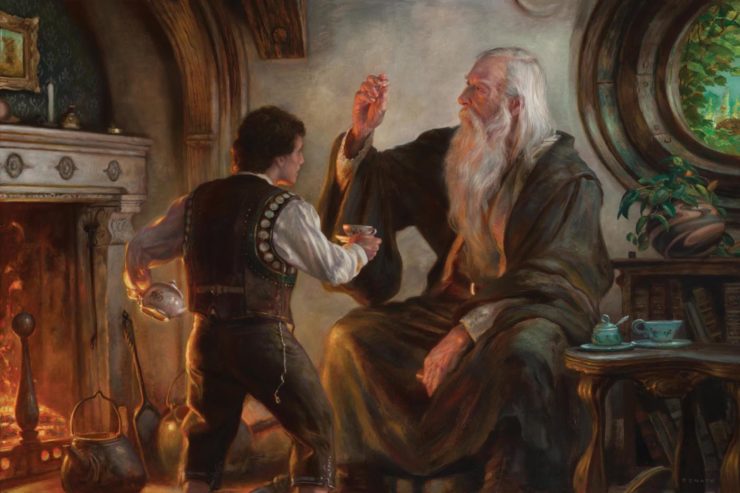
And much later, in “The Last Debate” (Chapter 9 of Book 5), Gandalf the White makes it clear that this would mean game over for Middle-earth, “so complete that none can foresee the end of it while this world lasts.” Then he paraphrases his famous “all that we have to decide is what to do with the time that is given us” proverb, this time with some fascinating agrarian, even meteorological, metaphors. In this scene, Gandalf is giving a grim pep talk to the Captains of the West in the tents outside Minas Tirith after the devastating but victorious Battle of the Pelennor Fields. He is pointing out that even if they succeed in holding off the armies of Mordor longer and the Ring does get destroyed, it’s still not the victory to end all victories:
Other evils there are that may come; for Sauron is himself but a servant or emissary. Yet it is not our part to master all the tides of the world, but to do what is in us for the succour of those years wherein we are set, uprooting the evil in the fields that we know, so that those who live after may have clear earth to till. What weather they shall have is not ours to rule.
There’s a whole lot in that passage; I love it so much.
Now, this is the second time we’re told that Sauron is—or was—a servant of someone else, someone worse. The first time is when Strider tells the hobbits the Tale of Tinúviel, in which the Elf-maiden Lúthien rescues her mortal boyfriend, Beren, from the dungeons of Sauron. These were Sauron’s pre-Mordor days, when he occupied a tower he’d stole from Galadriel’s big brother and he (Sauron) was but a servant to the “Great Enemy” who sat on a throne in Angband in the far north.
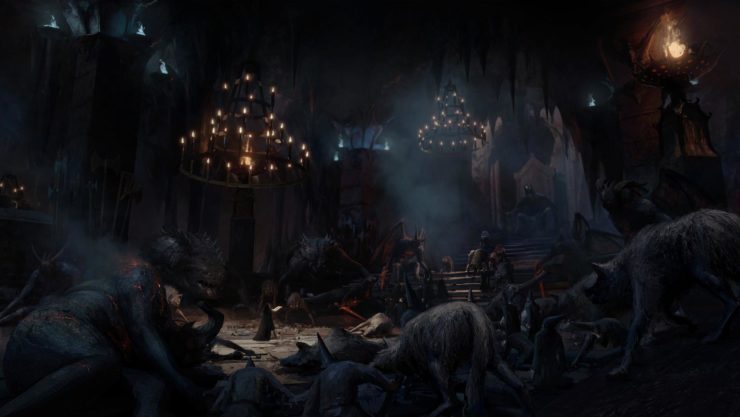
This big boss was a huge problem for the Elves and Men of that age. It’s pretty much what The Silmarillion is about. Interestingly enough, the only time said Enemy is actually named in the main text of The Lord of the Rings is in Lothlórien, when Legolas identifies the whip-wielding, wingless Terror they bumped into in Moria only two days before. He calls it “a Balrog of Morgoth.”
Ohh, and quick aside: It’s a bit heartbreaking when you look at the year 3019 timeline in Appendix B and see that even as the Company is reporting the bad news about Gandalf to Celeborn and Galadriel—and everyone’s sad and still trying to come to terms with it—the wizard is still fighting the Balrog Durin’s Bane in the depths of Khazad-dûm. It’s a protracted, week-and-a-half-long battle for these two ancient beings (with possible on-again, off-again clashes and tussles), only concluding on the tenth day at the peak of Zirakzigil.
That Gandalf. What a badass.
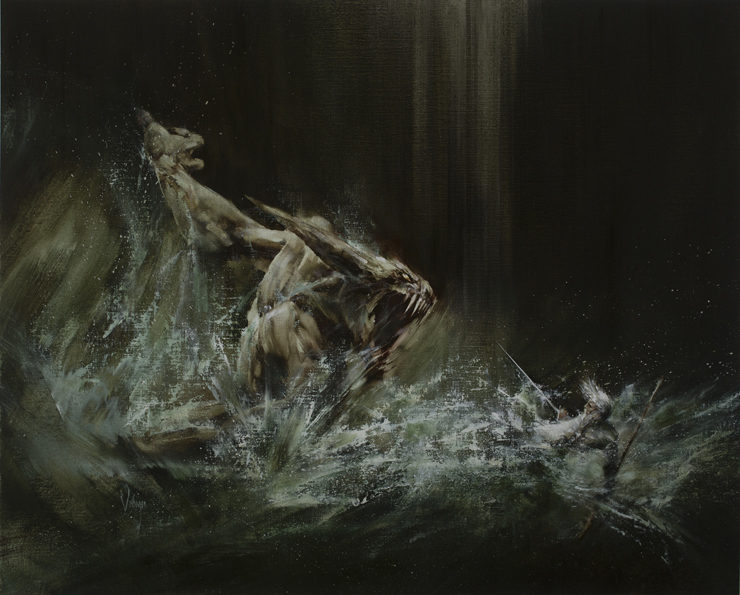
But anyway, Legolas’s name-drop of Morgoth is the only occurrence outside of the Appendices. So he’s not such a big deal in The Lord of the Rings, just some has-been Dark Lord. Casual readers of Tolkien unfamiliar with the legendarium at large might think: So all right, this Morgoth is already long gone from the world, leaving Sauron the only clear and present “evil in the fields” that needs uprooting—at least in Gandalf’s analogy. Yet if Sauron is soon to be “maimed” by the destruction of the One Ring, then what’re those other evils that may still come?
“What weather they shall have is not ours to rule.” …What’s Gandalf really talking about in those tents?
He’s connecting this presumably inclement weather with evil, or at least unknown calamities that may yet arrive. I don’t think he’s referring to other Maiar, immortal beings like Sauron, Saruman, or any remaining Balrogs who may arise in the future to wreak havoc; if he were, they’d likely just be more evil crops in his metaphor. But weather? Those are the variable troubles that come with an unpredictable and imperfect world. A world where a certain measure of evil was baked in at the start and is going to stir up the weather. And this is where Tolkien’s legendarium most strongly aligned with his Christian beliefs in our world. Thus is Middle-earth compatible with (not to be mistaken with “the same as”) Regular-earth.
Buy the Book
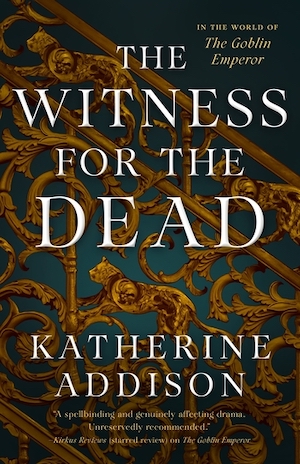

The Witness for the Dead
Extending Gandalf’s weather metaphor, think of it like…climate change. Sure, there’s wind and rain and even forest fires, and those things aren’t going to prevent future people from having “clear earth to till”—quite the contrary, actually. They are natural. But what about worsening weather stemming from a planet that’s got some intrinsic problems that aren’t as originally intended? Problems created by human beings that affect the natural world, increase greenhouse gases and lead to rising waters, heat waves, droughts, the desolation of flora and fauna, stronger hurricanes… In the real world, well, the intrinsic problems are us. They arise from our meddling.
But on Middle-earth? We’re talking about evil—spiritual, physical, metaphysical. And that brings us back to Morgoth. So why is he to blame for “weather” yet to come? Why not blame Men directly, based on their earliest failings, à la Adam and Eve; or even the Elves? Well, they aren’t entirely off the hook, but evil in Arda precedes such incarnate beings. Precedes even the Sun and Moon.
As we ponder these questions, here are some helpful vocab words for easy reference:
- Ainur — The Holy Ones, the “offspring” of Ilúvatar’s thought. The beings that joined in the Music of creation, and included those who would become categorized as the Valar and the Maiar.
- Arda — The world (little “w”), which includes the Earth, the seas, skies, and even the firmament around them (the planet and its immediate celestial surroundings).
- Arda Marred — The version of Arda that is, as a consequence of Melkor’s primordial meddling, not precisely the version of Arda that was meant to be.
- Children of Ilúvatar — Both Elves and Men. Biologically, these two races are of the same “species” and as such can “produce fertile offspring,” but the relationship between their respective spirits and bodies mark the greatest distinction between the two. It may be said that Dwarves are “adopted” Children of Ilúvatar.
- Eä — All of creation, the World (big “w”), the entire universe itself, of which Arda is but a part.
- Ilúvatar — Eru, The One, the singular god of Tolkien’s monotheistic legendarium.
- Maiar — Powerful spirits that were around before Arda itself. They are of a lesser order than the Valar, but some are nearly as mighty. Gandalf, Sauron, and Balrogs are all Maiar.
- Men — Humans, men and women both.
- Middle-earth — The massive continent where most of the stories in the legendarium take place. Contains regions like Eriador and Rhovanion. Beleriand once formed its northwestern corner.
- Melkor a.k.a. Morgoth — The Enemy, the original Dark Lord and fomenter of all evil. Formerly the mightiest of the Ainur.
- Music of the Ainur — The grand harmonic production that became the foundation of the universe. Though all the Ainur participated, Melkor added some discord to the Music.
- Valar — The “agents and vice-gerents” of Eru, the upper echelon of spiritual beings, set above the Maiar, and established by Ilúvatar to shape and govern Arda.
- Valinor — The realm of the Valar in the West, often synonymous with the Undying Lands. Inaccessible to mortals, especially in the Third Age.
Readers of The Silmarillion know that Morgoth is Public Enemy No. 1. He is the Ainu formerly known as Melkor—one of the Valar, in fact, if only briefly. He is later labeled Morgoth (Sindarin for “dark foe”), the Dark Enemy of the World, and he’s the first and greatest evildoer against the just authority of Eru Ilúvatar, a.k.a. God. He’s the chief antagonist in The Silmarillion, whose direct and indirect actions drive every plot.
Most stories are about what happens when things go wrong, right? And in fiction an active villain is usually behind that. There would be no Harry Potter series if Voldemort wasn’t fixing to return and dominate the wizarding world. Luke wouldn’t have gone anywhere if the Galactic Empire hadn’t built a planet-destroying battle station that needed thwarting. And the people of Santo Poco wouldn’t need saving at all if the actual El Guapo wasn’t trying to kill them.
In Middle-earth, though, Melkor is everyone’s El Guapo.
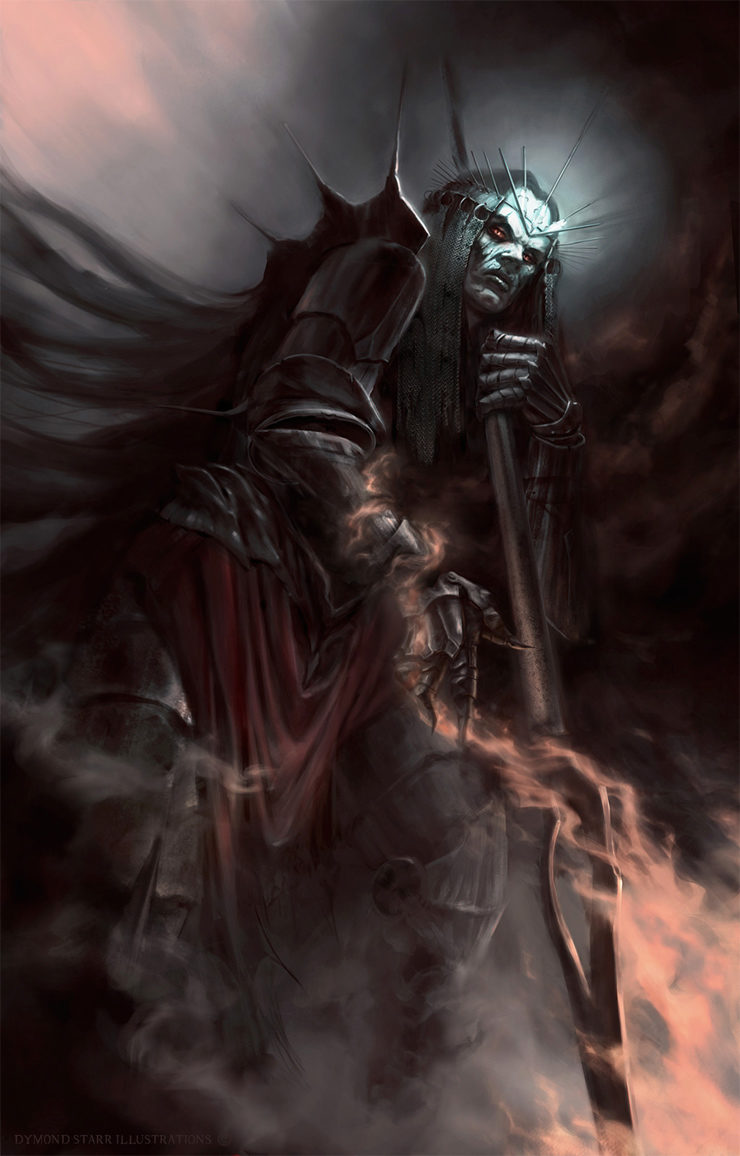
He actively sabotages all that is good and natural because he didn’t make them and he hates that. His existence in Arda is essentially one big rampage; when he’s not wrecking things, he’s constructing puppets to wreck things for him. He makes monsters, he murders people, he makes monsters murder people, and he gets folks of every race to fight one another. He’s literally the worst. But even at the end of the First Age, when the Valar finally yank him offstage with their gigantic vaudeville hook, his legacy lives on in the very fabric of the world. Literally. And that’s why even though Sauron gets both the Second and Third Ages to terrorize, Morgoth’s legacy endures even when Sauron goes under.
So…how? We have to go real far back to explore this question, because even in the Elder Days, when the dramas of the First Age and the wars with the Elves, Men, and Dwarves were unfolding, Morgoth had already stained the world.
In a nutshell, this is how: In the beginning of all beginnings, Melkor started off as a wunderkind rebel, creating strife and discord simply because he wants to call the shots and be seen as better than everyone else—his was a serious case of cosmic pride. And because he was too “impatient” with the emptiness of the Void, he tried to find and steal the Imperishable Flame (the source of all life and creation) from Ilúvatar. That didn’t work out for him, so—after spitefully disharmonizing with the Music of the Ainur that created the blueprints for the universe—he settled for just trying to master the world of Arda by volunteering to help “order” it alongside his peers, the Valar. We’re told he even fooled himself into thinking he meant to make amends.
When the Valar first entered the universe (Eä) from the outside, they found that Arda was only freshly out of the oven, still soft and not completely cooked—parboiled, if you will. They had work to do, to shape it according to the vision Ilúvatar had shown them of the world (which had, in turn, been shaped by their Music). And so, led by Manwë, the King of Arda, and his wife Varda Star-kindler (of O Elbereth! Gilthoniel! fame), the Valar collectively rolled up their sleeves…
but Melkor too was there from the first, and he meddled in all that was done, turning it if he might to his own desires and purposes; and he kindled great fires. When therefore Earth was yet young and full of flame Melkor coveted it, and he said to the other Valar: ‘This shall be my own kingdom; and I name it unto myself!’
Through all of this contention, simply by causing such distress and disruption, Melkor seeded corruption in the world. This was him at his most powerful, a force to be reckoned with. Again and again he ravaged the Valar’s labors, but together they persisted and gradually made Arda retain its shape. So Melkor had to settle for merely despoiling it, just so, and this is the marring that gets mentioned throughout The Silmarillion and in the HoMe books. But it’s only in the latter that you can really read how profound the result is.
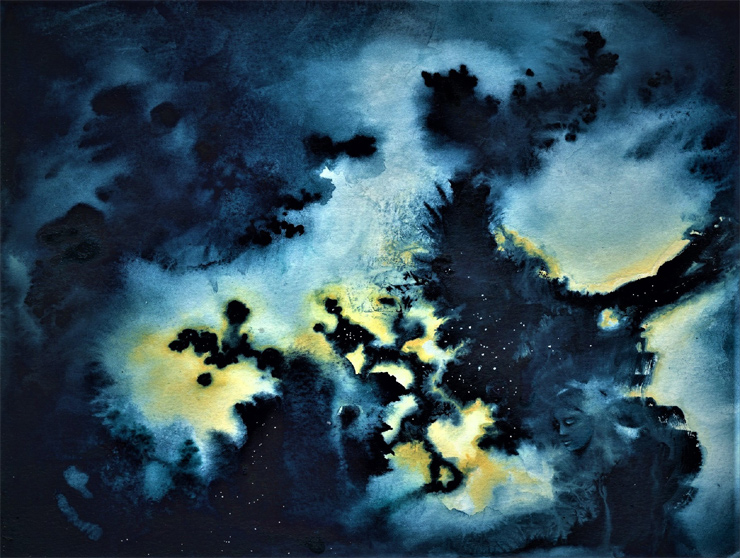
Now let’s look at Morgoth’s Ring, volume 10 of The History of Middle-earth. The essays, stories, and lore of this series can always provide further insight into Tolkien’s world or offer an additional perspective, but it should be understood that it’s not all internally consistent, as Tolkien’s son Christopher points out often enough. And remember, also, that a great deal of it was written after The Lord of the Rings, and isn’t necessarily perfectly aligned to the author’s thinking during the writing of that book.
Still, according to his essays in the wonderful “Myths Transformed” chapter, Tolkien explains that while Morgoth couldn’t destroy the world, he was able to tarnish it by diffusing a significant amount of himself into everything. Into the fabric of all things. It’s still a beautiful world, yes—such that the Elves adore it and Men think it’s at least a’ight—but if you look close enough, there are cracks. Or, more like Melkor left skidmarks on just about everything—sometimes overtly, sometimes barely noticeable. Thus in Morgoth’s Ring, Christopher Tolkien relates to us, his father:
contrasted the nature of Sauron’s power, concentrated in the One Ring, with that of Morgoth, enormously greater, but dispersed or disseminated into the very matter of Arda: ‘the whole of Middle-earth was Morgoth’s Ring.’
Thus Arda as intended became Arda Marred. Nothing’s quite as it was designed to be. So what about the Children of Ilúvatar? You know, the Elves and Men for whom Arda was made in the first place and because of whom Morgoth got his ass handed to him a few times. They popped up in Arda only after the marring. Shouldn’t they be exempt from such imperfection? Well…
To gain domination over Arda, Morgoth had let most of his being pass into the physical constituents of the Earth—hence all things that were born on Earth and lived on and by it, beasts or plants or incarnate spirits, were liable to be ‘stained’.
Elves and Men, though they appeared millennia apart and in different geographic locations, both awakened on a marred Middle-earth. They are made from and sustained by the substances Morgoth infected.
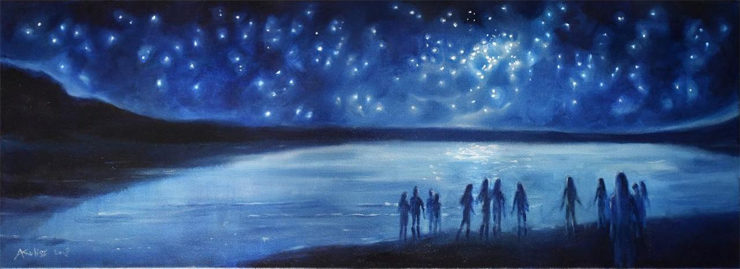
The same is true for the Dwarves, as adopted Children of Ilúvatar, and even beings like Ents. All imperfect, if still generally great. As Treebeard says, even Ents can go “tree-ish” (becoming less like themselves). And trees and Huorns, though born of the natural world, can develop “bad hearts,” and not because of sick or rotting wood. It’s a spiritual problem, a consequence of that bit of fallen ex-Vala in them. When it comes to specimens of nature turning sour, one need look no further than Old Man Willow.
Anyway, “Myths Transformed” also gives us a fascinating contrast-and-compare between Sauron and Morgoth worthy of its own topic. But one snippet relevant to this topic is:
Melkor’s final impotence and despair lay in this: that whereas the Valar (and in their degree Elves and Men) could still love ‘Arda Marred’, that is Arda with a Melkor-ingredient, and could still heal this or that hurt, or produce from its very marring, from its state as it was, things beautiful and lovely, Melkor could do nothing with Arda, which was not from his own mind and was interwoven with the work and thoughts of others: even left alone he could only have gone raging on till all was levelled again into a formless chaos.
First, this means Melkor could do nothing in pursuit of his real desire, which was to wreck it all (even his own monsters) and make things of his own from whole cloth. #DarkLordGoals
So ruining everyone’s days as much as possible was still only second best.
Also: “a Melkor-ingredient”! This means there is a tiny dash of him in all things, or nearly all things, and it’s ultimately why the Children of Ilúvatar generally can’t catch a break (for long). So if you’re in Middle-earth and you pick up just about anything—say, breakfast cereal, some Longbottom Leaf, or Drive-Thru Southwest Style Taco Hot Pockets®—and flip to the side of the box, it might look something like this.
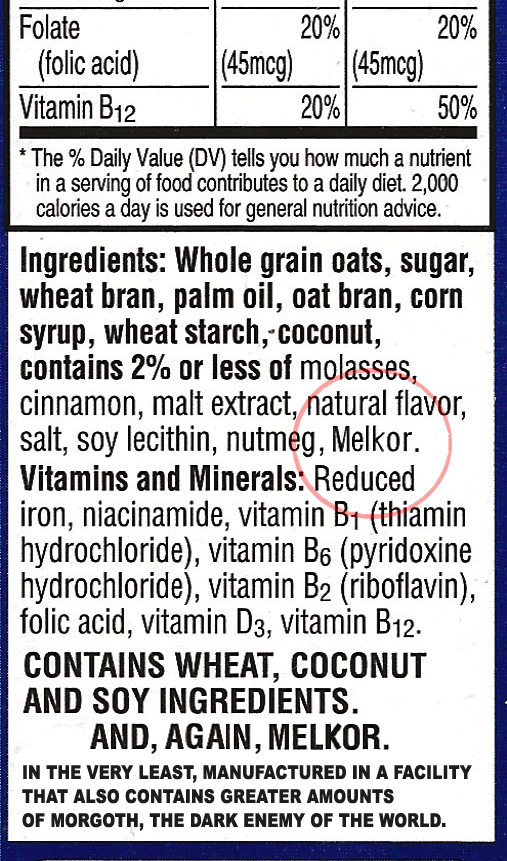
Anyway, Tolkien does give us a couple of examples. The substance of gold, of which the One Ring appears to be made (at least in part), is called out as being particularly saturated with the Melkor-ingredient. Which, when you think about the lust for gold that Men, Dwarves, and dragons tend to have, makes more sense.
For example, all gold (in Middle-earth) seems to have had a specially ‘evil’ trend—but not silver. Water is represented as being almost entirely free of Morgoth. (This, of course, does not mean that any particular sea, stream, river, well, or even vessel of water could not be poisoned or defiled—as all things could.)
So this is how Melkor squandered his power. The major downside, for him: It made what remained of him weaker and“incarnate, confined to a physical form (“a dark Lord, tall and terrible”). This prevented him, among other things, from walking “unclad, as could his brethren,” an incorporeal shape; he couldn’t ascend into the sky and tear down the Sun he hated (when the Sun became a thing), and couldn’t raise up land masses like he’d done the Misty Mountains! And so by the time of his wars against the Elves, which started with the theft of the Silmarils, he was forced to hide out in his Angband bunker for the rest of that age.
Except for that one time, when he came out in person to deal with a pesky High King of the Noldor who rightly called him out for being “craven.”
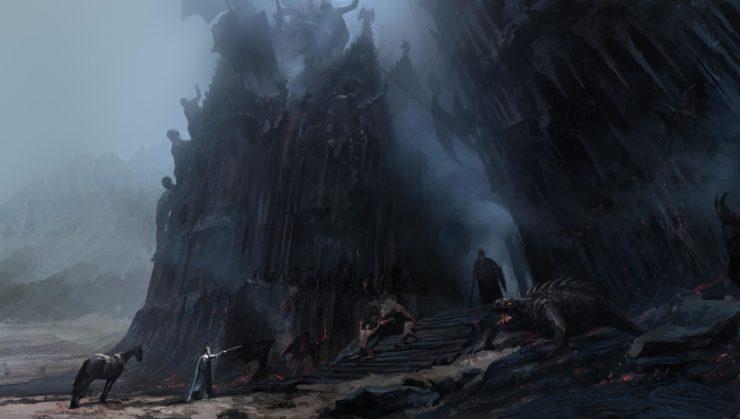
Oh, and possibly maybe that one other time? The jury’s still out on that one.
And sure, even a nerfed Morgoth could still wage war with the Elves, sow suspicion and doubt among all the Children of Ilúvatar within his reach, turn individuals against their own kind with his spies and emissaries, oversee the breeding of dragons and other monsters, and keep the wheels of Orc propagation turning. But in the end, being incarnate also meant Morgoth could—and does—get dragged out his basement by force after the War of Wrath, when his Dark Lord term was up. Which is a satisfying (if too-short) read in The Silmarillion.
But the upside, from Morgoth’s point of view: the successful spoiling of all Arda. Everything that is bad or goes wrong in the world can be attributed to, at least in some small part, to him. Hangnails? A consequence of Arda Marred, so that’s Morgoth’s fault. Stepping on a LEGO? Morgoth again. The term “hubby”? Morgoth indeed.
But those are the little things. The big things include Men’s fear of death, the Gift of Ilúvatar, and the fact that Elves can have their spirits (fëar) and their bodies (hröar) separated. They can “die” by various means, which wasn’t part of the original plan. Elves were supposed to have their spirits and bodies inseparable from the start. But because of the Melkor-ingredient, in the very substance that an Elf’s body is grown from and in the food that she eats, the infrastructure of her very being is compromised. Thus, the Valar had to devise a system for the gathering of Elf-spirits whose bodies were slain, a system for cleansing them in the Halls of Mandos, and a solution for rehousing them again in new bodies.
Really, everything the Valar do to manage the imperfections of the world is a patch, a workaround, a plan B. There is talk in the HoMe books of an eventual Arda Remade, and in The Silmarillion there is a foretelling of the “Second Music of the Ainur,” but that’s always far off. So long as this Arda lasts, however many millennia and ages it goes on, through and maybe beyond the Dominion of Men “and the decline of all other ‘speaking-peoples’ in Middle-earth,” it will remain marred in this way.
Evil is just a component of the world and it always has been. Gandalf knows that those Melkor-ingredients will beget foul weather from time to time, though it is not for him, the Captains of the West, or anyone in Middle-earth circa 3019 to resolve. Yet in discussing how nearly all matter includes tiny traces of Morgoth in it, there’s one little statement that Tolkien tosses in like a throwaway line. He even places it in parentheses:
(It was this Morgoth-element in matter, indeed, which was a prerequisite for such ‘magic’ and other evils as Sauron practised with it and upon it.)
Stop the presses! That’s what magic is?! So there is a kind of magic system in Tolkien’s world after all—well, of evil magic, and it’s hardly quantified for us. Also, “sorcery” might be the better word, as it’s always used in conjunction with the bad guys, or those who deal in deception. For example, Éomer is suspicious when he first meets Aragorn, Legolas, and Gimli, who admit they have the favor of the Lady of the Golden Wood, observing, “Few escape her nets, they say. These are strange days! But if you have her favour, then you are also net-weavers and sorcerers, maybe.”
It can be said, then, that microscopic spiritual traces of Morgoth—formerly the “mightiest of all the dwellers in Eä”—is the material component for the spells of sorcerers great and small. Sorcerers like the Mouth of Sauron, and others before him who served Sauron, and the Witch-king himself, “a great king and sorcerer he was of old.”
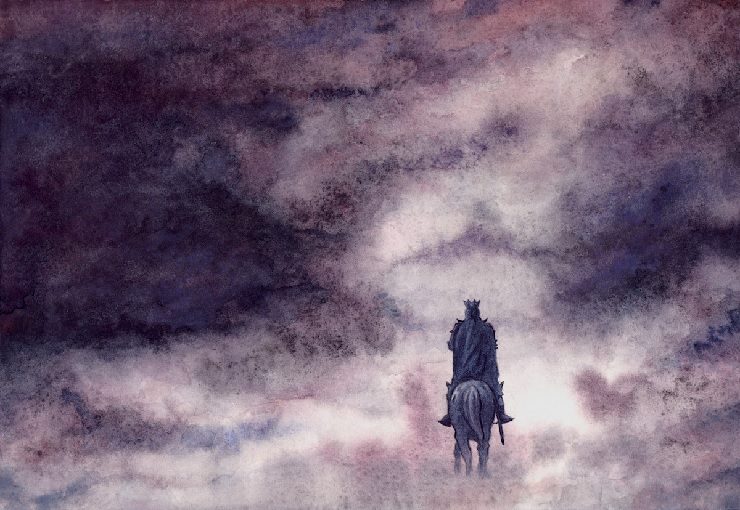
They didn’t call him Ol’ Witchy for nothing.
Of course, Sauron (in the absence of Morgoth) is the chief user of such dark magic. You might think, well, he’s one of the Maiar, and a particularly strong one. Obviously his power came from Ilúvatar before the universe was made, before he went bad. Yes, quite true. Yet in The Silmarillion we’re told—many chapters in, mind you!—during the Beren and Lúthien story that “Sauron was become now a sorcerer of dreadful power, master of shadows and of phantoms…”
Was become now—as though he hadn’t been all along, hadn’t been since springing out of Ilúvatar’s thoughts, but rather learned to become so in Arda Marred under the regime of Morgoth. Learned how to manipulate Morgoth’s own disseminated self soaked into the fabric of the world.
Then thousands of years later, Sauron is also “the Necromancer” of Dol Guldur. The White Council doesn’t even know it’s really him for a long time and only later confirm it after Gandalf noses around its dungeons himself. A necromancer, in Tolkien’s legendarium, is one who communes with, manipulates, or somehow shelters the spirits of the dead. Such spirits, as described in Morgoth’s Ring, are called the Houseless or the Unbodied:
For the Unbodied, wandering in the world, are those who at the least have refused the door of life and remain in regret and self-pity. Some are filled with bitterness, grievance, and envy. Some were enslaved by the Dark Lord and do his work still, though he himself is gone. They will not speak truth or wisdom. To call on them is folly. To attempt to master them and to make them servants of one own’s will is wickedness. Such practices are of Morgoth; and the necromancers are of the host of Sauron his servant.
We get a reference to an untold number of his “followers” (presumably all Men, but who knows for sure?) who were taught such practices by him. Hence “necromancers,” plural. Then there are the phantoms and the “Dead Faces” who “light little candles” in the Dead Marshes just outside Mordor; that sure sounds like necromancy, too, though we’re never told for sure. Frodo only guesses that it may be “some devilry hatched in the Dark Land” upon the corpses in the marsh. And what of the Barrow-wights, who are also unspecified evil spirits? No matter their origin, we are told that they came from Angmar, where the Witch-king reigned. Once a normal mortal Man who was also a sorcerer, he presumably commanded them to inhabit the burial mounds of the Dúnedain there.
The point is, all these supernatural things seem to be made possible because of the residue Morgoth left behind. And this sketchiness with regards to magic also jibes with Galadriel’s reticence in accepting that word when she hears Sam talking about it with Frodo.
“And you?” she said, turning to Sam. “For this is what your folk would call magic, I believe; though I do not understand clearly what they mean; and they seem to use the same word of the deceits of the Enemy.”
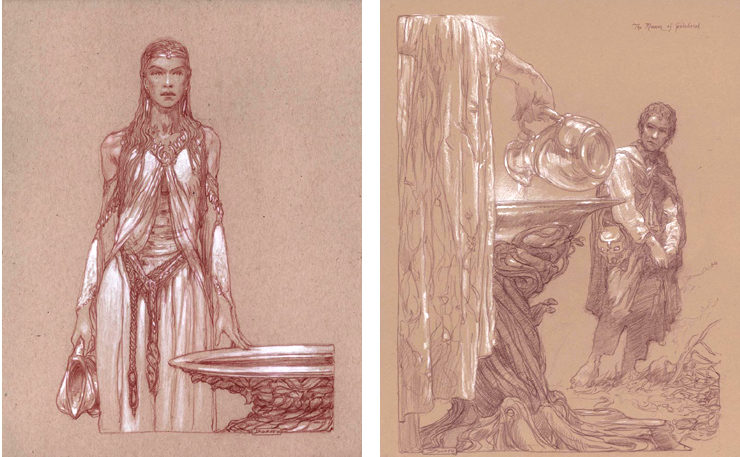
To her, the workings of Sauron would be sorcery. But her Mirror, her Phial, or Nenya? The Ring of Adamant actually aids in the protection and preservation of Lothlórien, so surely not. These objects clearly possess power, too, as Galadriel herself does, but in other legendarium books such works would be called simply “arts” or even “wizardry,” and it is likely more divine in origin—arts taught by the Valar, which the High Elves learned in Valinor. Galadriel’s own brother, Finrod Felagund, commanded such power when he joined the hero Beren on his great quest (as part of the aforementioned Tale of Tinúviel):
By the arts of Felagund their own forms and faces where changed into the likeness of Orcs; and thus disguised they came far upon their northward road . . .
So not all magic comes from the same place, that’s true enough. But Galadriel shies from the term, not wanting the deceits of the Enemy conflated with her own arts. One could say that the great works of Fëanor—like the Silmarils and the palantíri—were magical but not evil. Not sorcerous, not even close. (The “light of Eärendil’s star” in the Phial of Galadriel is the light of a Silmaril, and sure does bother Shelob!) That said, even Gandalf still calls some things magic if he knows that’s how others will understand it. He probably wouldn’t speak lightly of mere “magic” in a one-on-one conversation with Elrond, but to Frodo in Bag End he will, saying: “Magic rings are—well, magical; and they are rare and curious.”
What’s fascinating about the Rings of Power in particular is that they are all, except the One, made by Elves. Yet their forging is under the instruction of Sauron (in his guise as Annatar, Lord of Gifts ), so it could be argued that they are wrought, in part, with sorcery. One could surmise that Sauron provided some Morgoth-intensive raw materials for his whole One Ring To Rule Them All project. Given that nine Rings of Power end up making Ringwraiths and seven more at least inspire “wrath and an overmastering greed of gold” in the hearts of the Dwarves who get them, sorcery is probably more present than not. Only the three rings made by Celebrimbor, of which Nenya is one, didn’t involve Sauron’s personal touch at all—so their power is likely unstained. Yet their design owns some connection to Sauron’s Ring and cannot be safely used while the One is with him.
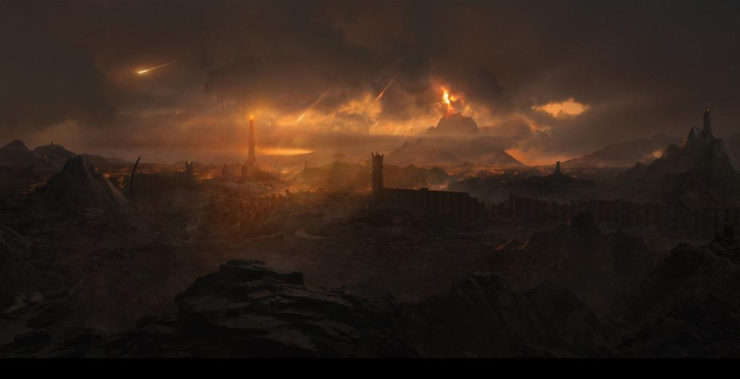
Still, those who learn how to manipulate the Melkor-ingredient in the world can therefore enact sorcery just about anywhere they go. Perhaps it’s sparse in most places (especially water) but eddied and clumped together more densely in others—like maybe wherever a dragon ends up lairing, or in the depths of Khazad-dûm (comfy for a Balrog), or the Cracks of Doom (the perfect place to set up an evil ring-forge). In short, per Morgoth’s Ring, “it is nowhere absent.”
This brings us back to Sauron at last, who “rose like a shadow of Morgoth and a ghost of his malice” in the Second Age shortly after Morgoth was cast out into the Void. Without anyone around to command him, and the Valar and their servants having withdrawn entirely from mortal shores, the coast is clear for him. Middle-earth becomes quite a playground for this uppity second Dark Lord.
Sauron was ‘greater’, effectively, in the Second Age than Morgoth at the end of the First. Why? Because, though he was far smaller by natural stature, he had not yet fallen so low. Eventually he also squandered his power (of being) in the endeavour to gain control of others.
It’s not like he had to expend any himself to make Orcs. That recipe had already been cooked up—and paid for in spirit-stuff—by his old boss, so Sauron had only to grease the wheels of production and exert his existing power over them. Remember, he only wants to rule and steer the course of the world, not destroy it utterly. So he sets himself up in Mordor and plays around with the world’s wonderful Melkor-rich ingredients just lying around, unused.
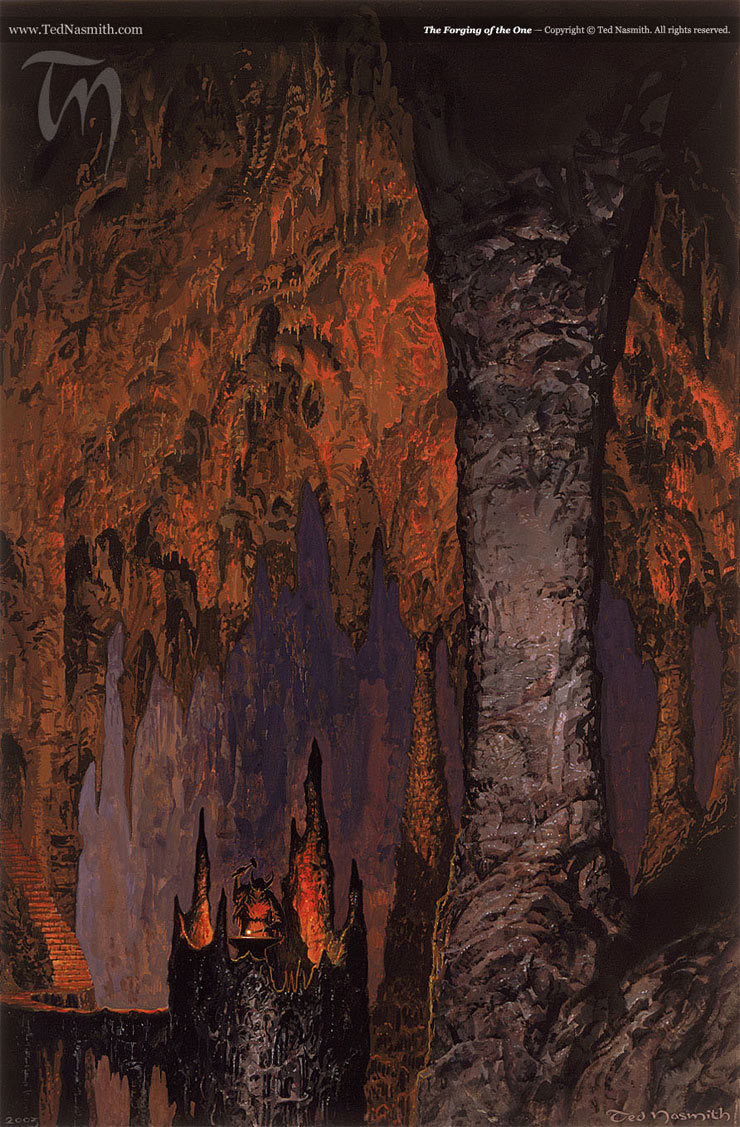
It isn’t until the creation of the One Ring, where he does expend so much of his being, that things take a gradual turn for him. That stratagem failed to achieve its original goal (dominion over the Elves) in the Second Age, but no one can say Sauron didn’t have a good run during his comeback in the Third.
So yeah, he falls into the same self-destructive “ruinous path” eventually, but up until Bilbo came along (or Gollum, for that matter) and started the chain reaction that brought the Dark Lord low, things had looked good for him. He’d been riding on the coattails of Morgoth, even in his absence. And yet when Sauron is finally reduced to a “mere spirit of malice that gnaws itself in the shadows,” the Melkor-ingredient remains, still present to trouble everyone by degrees.
To whatever weather.
Top image from “Morgoth, He Who Arises in Might” by Dymond Starr
Jeff LaSala can’t leave Middle-earth well enough alone, and is responsible for The Silmarillion Primer and the Deep Delvings series. Tolkien nerdom aside, Jeff wrote a Scribe Award–nominated D&D novel, produced some cyberpunk stories, and works in production for Macmillan and Tor Books. He is sometimes on Twitter.










